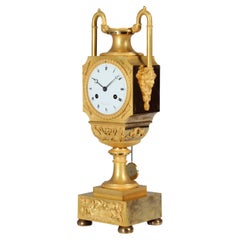Want more images or videos?
Request additional images or videos from the seller
1 of 17
Early 19th Century Pendule Portefaix, Mantel Clock, Paris and Brussels, c. 1810
$19,749.74List Price
About the Item
- Creator:J. J. Hanset Bruxelles 1 (Clockmaker),Jean-André Reiche (Artist)
- Dimensions:Height: 14.18 in (36 cm)Width: 11.03 in (28 cm)Depth: 4.34 in (11 cm)
- Style:Empire (Of the Period)
- Materials and Techniques:
- Place of Origin:
- Period:
- Date of Manufacture:1810
- Condition:Wear consistent with age and use. Very nice condition of the fire gilding with slight age-related rubbing. Movement cleaned from top to bottom and in perfect working order.
- Seller Location:Greven, DE
- Reference Number:1stDibs: LU5419241337392
About the Seller
4.9
Platinum Seller
Premium sellers with a 4.7+ rating and 24-hour response times
Established in 2014
1stDibs seller since 2020
198 sales on 1stDibs
Typical response time: 1 hour
Authenticity Guarantee
In the unlikely event there’s an issue with an item’s authenticity, contact us within 1 year for a full refund. DetailsMoney-Back Guarantee
If your item is not as described, is damaged in transit, or does not arrive, contact us within 7 days for a full refund. Details24-Hour Cancellation
You have a 24-hour grace period in which to reconsider your purchase, with no questions asked.Vetted Professional Sellers
Our world-class sellers must adhere to strict standards for service and quality, maintaining the integrity of our listings.Price-Match Guarantee
If you find that a seller listed the same item for a lower price elsewhere, we’ll match it.Trusted Global Delivery
Our best-in-class carrier network provides specialized shipping options worldwide, including custom delivery.You May Also Like
Early 19th Century French Empire Pendule Portefaix circa 1810 Paris
Located in Münster, DE
Paris, Empire, c. 1810, bronze body, fire-gilt and patinated, designed by Jean-André Reiche in 1808, 8-day movement, enamel dial with Roman numerals, figure of the wearer on an oval ...
Category
Antique Early 19th Century Table Clocks and Desk Clocks
Materials
Bronze, Enamel
$15,321
H 14.57 in W 11.03 in D 4.14 in
Fine 19th century French ormolu mantel clock (pendule) by Leroy a Paris, c. 1825
By LeRoy
Located in Oxfordshire, United Kingdom
A most beautiful French ornolu mantel clock by Leroy à Paris
A lovely French late Empire/early Charles X mantel clock with an ormolu case, c. 1825. The ormolu brass case depicts a celebration of Science and Learning. It is dominated by a rectangular superstructure containing the movement, flanked by an engine-turned column with a celestial globe on top on the left and an elegant lady reading a book on the right. The superstructure is surmounted by a bookcase and a bust of Socrates...
Category
Antique Early 19th Century French Empire Mantel Clocks
Materials
Brass, Ormolu
$10,303
H 18.12 in W 12.21 in D 4.14 in
French 19th Century Bronze with Marble Base Mantel Clock, Pendule
Located in Delft, NL
French 19th century Bronze with marble base mantel clock, pendule
A 19th century French mantel clock with bronze putti on a brown, red, whi...
Category
Antique 19th Century French Mantel Clocks
Materials
Marble, Bronze
$4,488
H 11.82 in W 7.88 in D 4.34 in
French Ormolu Mantle Clock, Pendule 'L'Angelot Endormi', Reiche, Paris, Ca 1820
Located in Vienna, AT
Excellent mantel clock made of fire-gilded and patinated bronze from the early 19th century:
Structure in the form of a tall oval, smooth, fluted stepped gilded base, recessed body m...
Category
Antique 1820s French Empire Table Clocks and Desk Clocks
Materials
Bronze
$6,702
H 13.39 in W 9.45 in D 5.91 in
Biedermeier Mantel Clock, Early 19th Century
Located in Stahnsdorf, DE
Biedermeier Mantel Clock, Early 19th Century
A sophisticated Biedermeier mantel clock, crafted in Austria circa 1810–1830. This exceptional piece combines timeless elegance with out...
Category
Antique 1810s Austrian Biedermeier Mantel Clocks
Materials
Maple
Mantel Clock 19th Century Empire
Located in Warsaw, PL
Figural mantel clock signed “Al. dre Destape Palais Royal”
The bronze figural mantel clock depicting one of the mythical heroes - Orpheus originates from the Empire period. The cloc...
Category
Antique Early 19th Century French Empire Mantel Clocks
Materials
Bronze
Mantel Clock 19th Century Styl Empire by Hartmann À Paris
Located in Warsaw, PL
An exceptional 19th-century Empire-style mantel clock by Hartmann à Paris, meticulously crafted in gilt bronze. This distinguished timepiece showcases a finely detailed white enamel ...
Category
Antique Early 19th Century French Empire Mantel Clocks
Materials
Bronze
$2,738 Sale Price
23% Off
H 16.15 in W 15.36 in D 4.73 in
Mantel Clock 19th Century Styl Empire by Cérés À Paris
Located in Warsaw, PL
Empire clock signed à Paris
The mantel clock is in gilded bronze representing Ceres as a goddess of fertility, agriculture, grain crops and motherly relationships. In ancient Rom...
Category
Antique Early 19th Century French Empire Mantel Clocks
Materials
Bronze
Mantel Clock 19th Century Styl Empire by Leroy à Paris
Located in Warsaw, PL
A magnificent 19th-century Empire-style mantel clock, signed by the esteemed clockmaker Leroy à Paris. This timepiece exudes classical elegance, featuring a finely detailed gilt bron...
Category
Antique Early 19th Century French Empire Mantel Clocks
Materials
Bronze
19th Century Empire Mantel Clock
Located in Ljungby, SE
An Empire mantel clock in gilded wood, made in Austria or Germany 1820-1830. It features a warrior dressed in classical armor with his arm resting atop the clock. The clock pillar is...
Category
Antique 19th Century European Empire Mantel Clocks
Materials
Wood
More From This Seller
View AllEarly 19th Century French Empire Mantel Clock, Portal Pendule, Paris circa 1820
By Duval
Located in Greven, DE
Antique French round arch portal clock
France (Paris)
Bronze, enamel
Empire circa 1820
Dimensions: H x W x D: 47 x 26 x 12 cm
Description:
Very beautiful, strictly architecturally...
Category
Antique Early 19th Century French Empire Mantel Clocks
Materials
Bronze, Enamel
Early 19th Century Ormolu Mantel Clock, Atala freeing Chactas, Paris, circa 1810
Located in Greven, DE
Mantel Clock "Atala and Chactas"
Paris
Bronze (fire-gilt and patinated), enamel
Empire around 1810
Dimensions: H x W x D: 40 x 32 x 11 cm
Description:
Very rare and extremely high quality French mantel clock, so-called Pendule Au Bon Sauvage.
Depicted are scenes from the love story "Atala or the love of two savages in the desert" written by Francois René Vicomte de Chateaubriand in 1801. At the beginning of the 19th century, this was probably the most famous love story in Europe, but today it has been forgotten.
The story, set in present-day Louisiana (USA), is roughly rewritten about the forbidden love between Chactas, a young Indian, and Atala, the beautiful daughter of a Spaniard.
Chactas is captured in a battle between two Indian tribes, chained to a palm tree and is to be sacrificed. Atala wants to save his life and convert him to Christianity. She unties him from the palm tree at night and they flee together into the wilderness of North America. Their love for each other grows stronger and stronger and they have prospects for a future together.
The story takes a tragic turn when Atala, who must remain a virgin due to a vow made by her mother, can no longer withstand the conflict of her feelings and commits suicide.
The main group of characters thus shows Chacta's liberation through Atala. Atala is leaning against a pile of logs. The animal fur thrown over the logs and the weapons leaning against the stack on the right give the impression of a night camp.
The bronze is of rarely beautiful quality, finely chiselled and makes the scene appear very lively. The contrast of fire-gilded and patinated bronze adds tension to the composition.
In the base we see the Entombment as the end of the tragic love story. This bronze work is also very detailed, the interplay of bright and matt gilding makes the flat relief appear much deeper than it is.
The depiction of the mantel clock presented here shows that the exotic was only known from stories and that the bronzier had his own ideas about the appearance of this distant world. The Indian, for example, has very European facial features and his skin was not black in reality, of course. The palm tree was also certainly not found in the North American wilderness.
The heart of the clock is a French pendulum movement, integrated into the wooden pile, with an eight-day power reserve and a lock plate striking a bell on the half and full hour. The pendulum is suspended on a thread, typical of the period. The classically shaped hands, so-called Breguet hands, are also typical of the time.
The enamelled dial has black Roman hour numerals, Arabic quarter hours and bears the signature: Le Roy hr. de Madame A PARIS.
Interesting facts:
The period from 1795 to about 1815 saw the creation of probably the most spectacular group of bronzes: The "Au bon Sauvage" pendulums - depictions of the "Noble Savage".
Today's viewers react to these objects with both fascination and irritation. Enthusiastic on the one hand about the obvious quality of the detailed bronzes and the allure of the exotic, on the other hand distanced and cautious because of the possible discrimination that is suspected behind them. The ambivalence of this feeling motivates the search for the conditions of origin of these pendulums.
Europeans found their new ideal of the natural man primarily in fictional and realistic travelogues about the Indians of North America...
Category
Antique Early 19th Century French Empire Mantel Clocks
Materials
Ormolu
19th French Empire Mantel Clock, Pendule, Mercury, Gilded Bronze, circa 1815
Located in Greven, DE
19th century French pendule, mantel clock - Mercury the messenger of the gods
France
Bronze gilded
Empire around 1815
Dimensions: H x W x D: 37 x 30 x 10 cm
Description:
French Empire...
Category
Antique Early 19th Century French Empire Mantel Clocks
Materials
Bronze
Early 19th Century Vase Pendule, Pendulum-Clock, Tardy à Lyon, Empire circa 1820
Located in Greven, DE
Antique vase clock
France
Fire gilded bronze
Empire around 1820
Dimensions: H x W x D: 41 x 13 x 12
Description:
Beautiful all gilt French mantel clock.
The basic form is in the shape of an urn vase with lid...
Category
Antique Early 19th Century French Empire Mantel Clocks
Materials
Bronze, Enamel
Early 19th Century French Mantel Clock, signed Ferey au Havre, Ormolu
Located in Greven, DE
Small mantel clock with bas-relief
France
Bronze, enamel
early 19th century
Dimensions: H x W x D: 33 x 19 x 9 cm
Description:
Antique, fire-gilt portal clock with figurative, Gre...
Category
Antique Early 19th Century French Empire Mantel Clocks
Materials
Bronze, Enamel, Ormolu
19th Century Mantel Clock "Astronomy", France circa 1830
Located in Greven, DE
Antique mantel clock on the theme of astronomy
France
Bronze
Charles X around 1830
Dimensions: H x W x D: 48 x 19 x 10 cm
Description:
Unusual and beautifully crafted bronze mante...
Category
Antique 19th Century French Charles X Table Clocks and Desk Clocks
Materials
Bronze
Recently Viewed
View AllMore Ways To Browse
Gilded Bronze Mantel Clock
Clock Heart
Antique Tobacco Signs
Pendule Empire
Jean Andre Reiche
Clock Reiche
Regulator A
18th Century Mantel Bronze
Antique Clock Movement Antique Clocks
Portico Clock
Rare Antique Mantel Clocks
French Mahogany Clock
Gold Rococo Clock
Mahogany Bracket Clock
Sevre Panels
Victorian Brass And Marble
Clock Finials
Clock Parts



